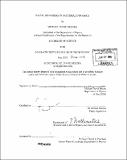Tactic behaviors in bacterial dynamics
Author(s)
Sekora, Michael David
DownloadFull printable version (6.828Mb)
Other Contributors
Massachusetts Institute of Technology. Dept. of Physics.
Advisor
Roman Stocker.
Terms of use
Metadata
Show full item recordAbstract
The locomotion of a wide class of motile bacteria can be mathematically described as a biased random walk in three-dimensional space. Fluid mechanics and probability theory are invoked to model the dynamics of bacteria swimming using tactic behaviors (movements or reorientation in response to chemical, physical or environmental stimuli) in flowing, viscous media. Physical descriptions are developed for bacterial chemotaxis (response to chemical agents) near particles exuding attractants, a small-scale process with global-scale implications for the biogeochemistry of the oceans. Three cases were investigated: a stationary particle, a slowly moving particle and a particle that generates a hydrodynamic wake in the form of attached vortices. The key finding of this thesis consists in the discovery of several scenarios in which motile bacteria swimming via random walks put themselves at a disadvantage in their quest for food with respect to non-motile pacteria. Thus, there exist threshold values in nutrient gradients and bacterial chemosensory ability below which bacteria would be better served if they did not swim. In the presence of vortices, it was discovered that bacteria can exploit the recirculating flow field to vastly increase their nutrient supply, but only if they alter their swimming behavior as a function of the concentration field. (cont.) Otherwise, slow bacteria completely miss the hydrodynamic wake (and the high nutrient region) behind a nearby moving particle, while fast bacteria end up colonizing the particle (i.e. clustering around the particle and potentially anchoring themselves to it). These processes are currently under investigation in laboratory experiments using high-speed digital photography, for which software (BacTrackTM) was written that can locate and track multiple bacteria over time, with the aim of providing trajectories and their statistics and ultimately establish the importance of these phenomena for marine ecology and biogeochemistry. Preliminary experiments were conducted with Escherichia coli being exposed to ultraviolet radiation, documenting the known result of E. coli being repelled by UV radiation and providing a successful test bed for the reliability of the tracking software.
Description
Thesis (S.B.)--Massachusetts Institute of Technology, Dept. of Physics, 2005. Includes bibliographical references (leaves 89-90).
Date issued
2005Department
Massachusetts Institute of Technology. Department of PhysicsPublisher
Massachusetts Institute of Technology
Keywords
Physics.